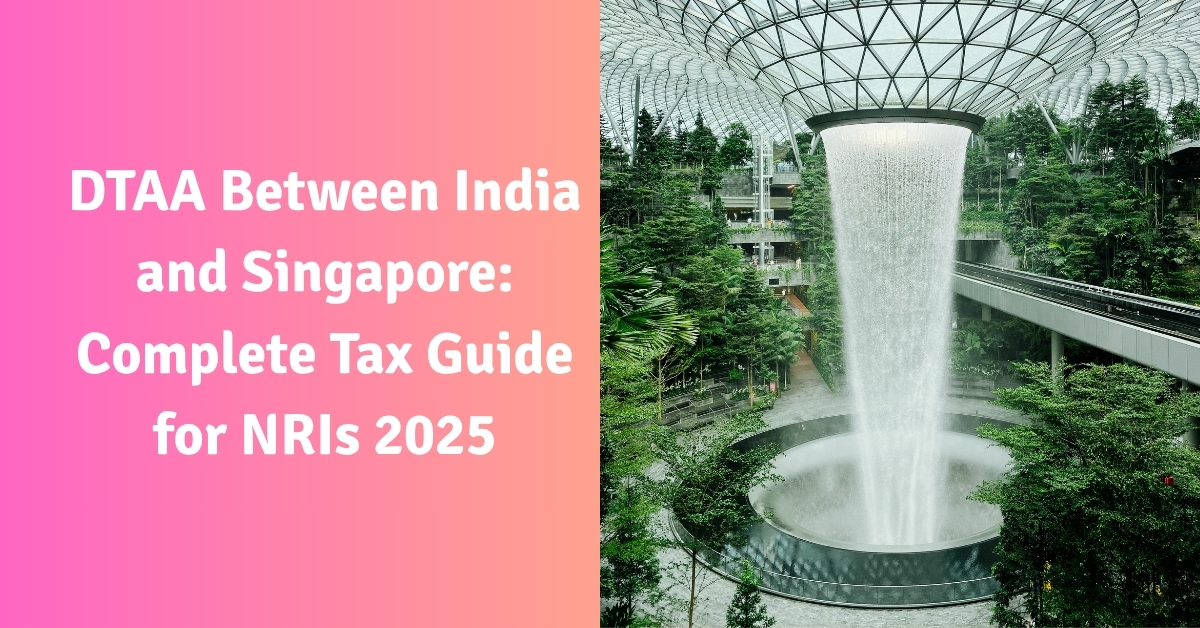DTAA Between India and Singapore: Complete Tax Guide for NRIs 2025

NRIs, think about that – you are earning in Singapore’s bustling Financial Centre, and your Indian mutual fund appreciation is tax-free – sounds like a fairy tale! Thanks to a strong Double Taxation Avoidance Agreement (DTAA) between India and Singapore, this is reality for you! This strong treaty has confirmed Singapore as the best place for Indian professionals, with one of the strongest tax protection arrangements there is.
There are upwards of 700,000 Indians living in Singapore and if you consider that Singapore is Asia’s Financial Capital, there are some big savings to be made by understanding this DTAA while ensuring you remain compliant. You have capital gain exclusions, reduced withholding taxes, and more. Let’s take a look at how you can utilize these to your advantage and create wealth across borders with ease.
What is the India-Singapore DTAA and Why It’s a Financial Goldmine
The Double Taxation Avoidance Agreement between India and Singapore has been updated numerous times, with some revisions as recently as 2024, and is one of the most extensive and beneficial tax treaties for NRIs. This bilateral agreement helps eliminate double taxation of income by residents of either country, making Singapore a highly favorable location for Indian professionals in the banking, technology, and trading spaces.
Under this agreement, residents of Singapore are fully exempt from Indian capital gains tax when investing in mutual funds, which is a huge benefit to take advantage of given the significant growth of the mutual fund market in India. The agreement also provides preferential rates for dividends (15%), interest (15%), and technical services so that your income across borders is optimally taxed.
This treaty operates based on source-based taxation for the majority of income types – income will typically be paid tax mainly where it is generated – but certain provisions ensure that residents of both countries are treated fairly and do not have to bear the burden of tax on the same income twice.
Fun fact: Singapore’s zero capital gains tax regime, combined with the DTAA exemption for mutual fund investments, makes it the most tax efficient potential base for Indian investors wishing to grow their wealth in Indian investment markets.
How to Determine Your DTAA Eligibility and Maximize Benefits
The process of claiming DTAA benefits can be summarized in a three-part strategy that will ultimately lessen your tax liabilities:
- Firstly, calculate your tax liability under the Indian Income Tax Act.
- Next, calculate your tax liability on the same income as a resident of Singapore (i.e, as per the provisions of the India-Singapore DTAA).
- Finally, choose the more beneficial alternative (treaty override under section 90(2)).
Your ability to access these significant benefits is based upon your residency in Singapore, which is recognized if you are physically present for 183 days or more per year or at least establishing Singapore as your “usual place of abode.” Once a Singapore residency is recognized, you may benefit from significant benefits, including capital gains exemption from Indian mutual funds, lower withholding tax, and protection from double taxation.
For example, as a Singapore resident, any capital gains from Indian equity mutual funds are free of Indian capital gains taxes. The element of this exemption is reflected in the courts decisions, and the exemptions can represent a fair amount of money compared to Indian residents who pay 10% LTCG taxes. Similarly, dividends from Indian companies taxed at only 15%, as opposed to paying even higher taxes as an Indian resident.
The main areas of confusion are how to keep documentation and what income is subject to treaty benefits versus taxing under domestic tax coverage.
Essential Documents for Claiming Your DTAA Benefits
In order to effectively benefit from DTAA in 2025, you will need to show your documents as follows – failing to provide any of the above documents could cost you thousands of dollars in meaningless taxes:
- Tax Residency Certificate (TRC) – A required certificate from the Inland Revenue Authority of Singapore (IRAS) that demonstrates your tax residency.
- Form 10F – Declaration from the Indian tax authority to allow you to claim treaty benefits.
- PAN Card – Required document for all Indian tax-related transactions (e.g., investments).
- Self-declaration – A witness statement confirming you can claim DTAA benefits.
If you are unable to produce the proper documentation in particular the TRC and 10F declaration, the alternative default tax rate will be punitive. Interest on NRO accounts for example could be subject to a 30.9% TDS instead of the optional 15% obligation under the DTAA. You may also find that dividend income could face higher rates of taxation without treaty protection.
Pro Tip – TRC’s will normally be processed in 14-21 working days by IRAS, but to be safe check in advance around peak periods. TRC and other document submissions will usually require some certified copies for multiple banks and investment platforms.
The documentation process also means that you will want to keep records of your Singapore tax residency for the TRC – these will most likely include or require employment contracts, lease agreements, and utility statements.
Singapore DTAA Tax Rates and Key Financial Benefits
The India-Singapore DTAA offers some of the most attractive tax rates available to NRIs, creating substantial savings opportunities:
| Income Type | DTAA Rate | Standard Indian Rate | Your Potential Savings |
|---|---|---|---|
| Interest Income | 15% | Up to 30.9% | Up to 15.9% reduction |
| Dividend Income | 15% | Higher domestic rates | Significant savings |
| Capital Gains (Mutual Funds) | 0% | 10–20% | Complete exemption |
| Royalties | 10% | 10% | Consistent treatment |
| Technical Services | 10% | Higher rates possible | Potential savings |
Employment Income: If you are earning a salary in Singapore, it will only be taxed in Singapore and you will be able to mitigate your Singapore tax liability through various allowances and reliefs available to residents with a little tax planning.
Capital Gains Goldmine: The golden advantage of this DTAA is that you do not pay Indian capital gains tax on your mutual fund investments. This means that income generated from SIP returns, lump-sum investment appreciation, and switching mutual funds will never create a tax liability in India.
Business Income: Profit is taxed in the country where the business is conducted. The corporate tax incentives and rates in Singapore are attractive to Indian entrepreneurs wanting to develop a regional headquarters.
Interest and Dividends: Both investments will attract the preferential 15% tax rate as opposed to the TDS rates commensurate with the risk, which can make debt investments and dividend-paying stocks more attractive for a resident of Singapore.
How to Claim DTAA Benefits Effectively and Strategically
Optimally leveraging benefits available under the DTAA requires careful planning and implementation. We have outlined the following detailed process to assist you with this:
- Identify and confirm eligibility: Firstly, confirm tax residency status in Singapore and evidence this accurately;
- Ensure you have the right documentation: Obtain the TRC from the IRAS and, if you are required it, have in place the Form 10F for Indian authorities;
- Work with the financial services providers (banks, brokers and AMCs): Provide the TRC, Form 10F and PAN to all and apply for reduced TDS so that tax deduction at source reflects the lower rate;
- Tax reporting: Ensure you accurately prepare your return to report foreign income and taxes in Schedule FSI and Schedule TR in your Indian return;
- Maximize available relief via Form 67: if you file Form 67 before your ITR, you will be able to apply for foreign tax credits and reliefs applicable to your tax calculation in India.
The DTAA will provide you with several mechanisms which you can use in combination to benefit from: Exemption Method: complete All taxes in one country (capitalize on the complete exemption for capital gains on mutual funds in Singapore!) Credit Method: Foreign taxes paid is received against your domestic tax liabilities.
Reduced Rates: In many instances tax has been withheld or deducted at source at reduced preferential rates.
Advanced techniques also include timing your investments and redemptions to maximize treaty benefits and structuring your portfolio to benefit from zero capital gains tax where possible, as well as further exploring tax opportunities in Singapore such as SRS contributions and other tax reliefs potentially available!
Pro tip: Maintain detailed investment records and transaction histories, as proper documentation becomes crucial during tax assessments or when claiming refunds of excess TDS deducted.
Conclusion
The India-Singapore Double Taxation Avoidance Agreement (DTAA) is a very valuable tax optimization tool for non-residents. The benefits include exemptions from capital gains, lower withholding taxes and full double taxation coverage. The overall benefits can substantially improve wealth cumulation strategies. However, being successful depends on residency obligations, documentation and staying on top of changes to the treaty. In order to maximize benefits and comply with changes in tax obligations, it is so important to have professional help and planning. A good financial planner and wealth manager like Prime Wealth who is also experienced in cross-border financials offers skill and peace of mind.
FAQs
1. Are my mutual fund gains really tax-free as a Singapore resident?
Ans- Yes, capital gains from Indian mutual funds are completely exempt from Indian tax for Singapore tax residents.
2. What documents do I need to claim the capital gains exemption?
Ans- You need a Tax Residency Certificate from Singapore IRAS and Form 10F submitted to your fund house or broker.
3. Can I claim reduced TDS rates on my Indian bank deposits?
Ans- Yes, submit your TRC and Form 10F to claim 15% TDS instead of the standard 30.9% rate.
4. How long does it take to get a TRC from Singapore?
Ans- IRAS typically processes TRC applications within 14-21 working days during normal periods.
5. Do I need to pay tax in Singapore on my Indian investment gains?
Ans- Singapore doesn’t tax capital gains, so your Indian mutual fund profits remain tax-free there too.
6. Can I get refunds if excess TDS was deducted before submitting DTAA documents?
Ans- Yes, file an Indian tax return to claim refunds of excess TDS deducted without treaty benefits.
7. What happens to my DTAA benefits if I lose Singapore tax residency?
Ans- You’ll lose treaty benefits from the date you cease to be a Singapore tax resident.
8. Are dividends from Indian companies taxable in Singapore?
Ans- Singapore doesn’t tax most foreign dividends, so you benefit from the 15% Indian rate without Singapore tax.
9. Can I claim DTAA benefits on rental income from Indian property?
Ans- Rental income remains taxable in India, but you may claim foreign tax credits in Singapore.
10. Is there a minimum investment amount to qualify for capital gains exemption?
Ans- No, the capital gains exemption applies regardless of your investment amount in Indian mutual funds.



